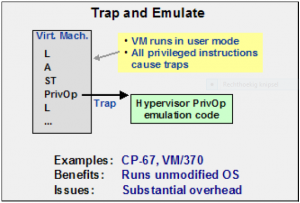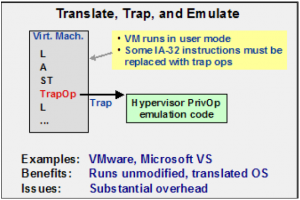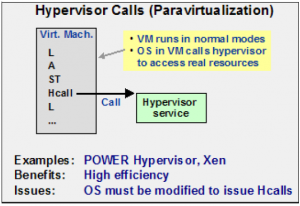Virtualization Concepts: Difference between revisions
No edit summary |
No edit summary |
||
| (One intermediate revision by the same user not shown) | |||
| Line 20: | Line 20: | ||
Before concluding the server virtualization presentation, it is useful to discuss the important hypervisor technologies used. | Before concluding the server virtualization presentation, it is useful to discuss the important hypervisor technologies used. | ||
[[File:Virtualization -Trap and emulate.png|thumb|right]] | [[File:Virtualization -Trap and emulate.png|thumb|right|baseline]] | ||
=====Trap and emulate method===== | =====Trap and emulate method===== | ||
In this method, a guest operating system runs in user mode and the hypervisor runs in privileged mode. Privileged instructions issued by guest operating systems are trapped by the hypervisor. This technology was originally used by mainframes in the 1960s and 1970s (VM/370). | In this method, a guest operating system runs in user mode and the hypervisor runs in privileged mode. Privileged instructions issued by guest operating systems are trapped by the hypervisor. This technology was originally used by mainframes in the 1960s and 1970s (VM/370). | ||
[[File:Virtualization - Translate, trap and emulate.png|thumb|right]] | [[File:Virtualization - Translate, trap and emulate.png|thumb|right|baseline]] | ||
=====Translate, trap and emulate method===== | =====Translate, trap and emulate method===== | ||
The translate, trap and emulate method is almost identical to the trap and emulate method. The difference is that some of the guest instructions must be replaced with trap operations, so some guest kernel binary translation may be required. | The translate, trap and emulate method is almost identical to the trap and emulate method. The difference is that some of the guest instructions must be replaced with trap operations, so some guest kernel binary translation may be required. | ||
[[Image:Virtualization - Hypervisor calls (Paravirtualization).png|thumb|right]] | [[Image:Virtualization - Hypervisor calls (Paravirtualization).png|thumb|right|baseline]] | ||
=====Hypervisor call method (paravirtualization)===== | =====Hypervisor call method (paravirtualization)===== | ||
Latest revision as of 16:20, 26 November 2013
Hypervisor-based partitioning
Type-1 Hypervisor
Type-1 hypervisors have the function implemented as part of the operating system software or the hardware firmware on a given hardware platform. When the hypervisor is implemented as part of the operating system, this operating system providing the hypervisor function is called the “host” operating system. The operating system running inside a virtual machine (VM) created on the host system is called the “guest” operating system.
z/VM is an example of a Type-1 Hypervisor. Some other examples are the Xen OpenSource Hypervisor, VMWare ESX Server, Virtual Iron, and ScaleMP.
Type-2 Hypervisor
Type-2 hypervisors are hypervisors running on a host operating system as an application. In this case, the host operating system refers to the operating system on which the hypervisor application is running. The host operating system runs directly on the hardware. The operating system running inside the virtual machine (VM) created using the hypervisor application is the guest operating system in this context.
VMWare GSX, Microsoft® Virtual Server, Win4Lin, and UserModeLinux are some examples of this type of hypervisor.
Hypervisor technologies
Before concluding the server virtualization presentation, it is useful to discuss the important hypervisor technologies used.
Trap and emulate method
In this method, a guest operating system runs in user mode and the hypervisor runs in privileged mode. Privileged instructions issued by guest operating systems are trapped by the hypervisor. This technology was originally used by mainframes in the 1960s and 1970s (VM/370).
Translate, trap and emulate method
The translate, trap and emulate method is almost identical to the trap and emulate method. The difference is that some of the guest instructions must be replaced with trap operations, so some guest kernel binary translation may be required.
Hypervisor call method (paravirtualization)
In the hypervisor call method (also known as paravirtualization), a guest operating system runs in privileged mode and the hypervisor runs in super-privileged mode.
The guest operating system kernel (for example, AIX®, i5/OS®, or Linux®) is modified to do hypervisor calls for I/O, memory management, yield rest of time slice, and so on. Memory mapping architecture is used to isolate guests from each other and to protect the hypervisor.


